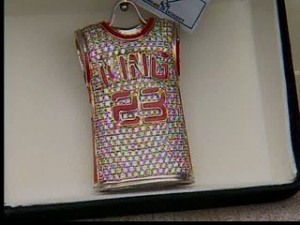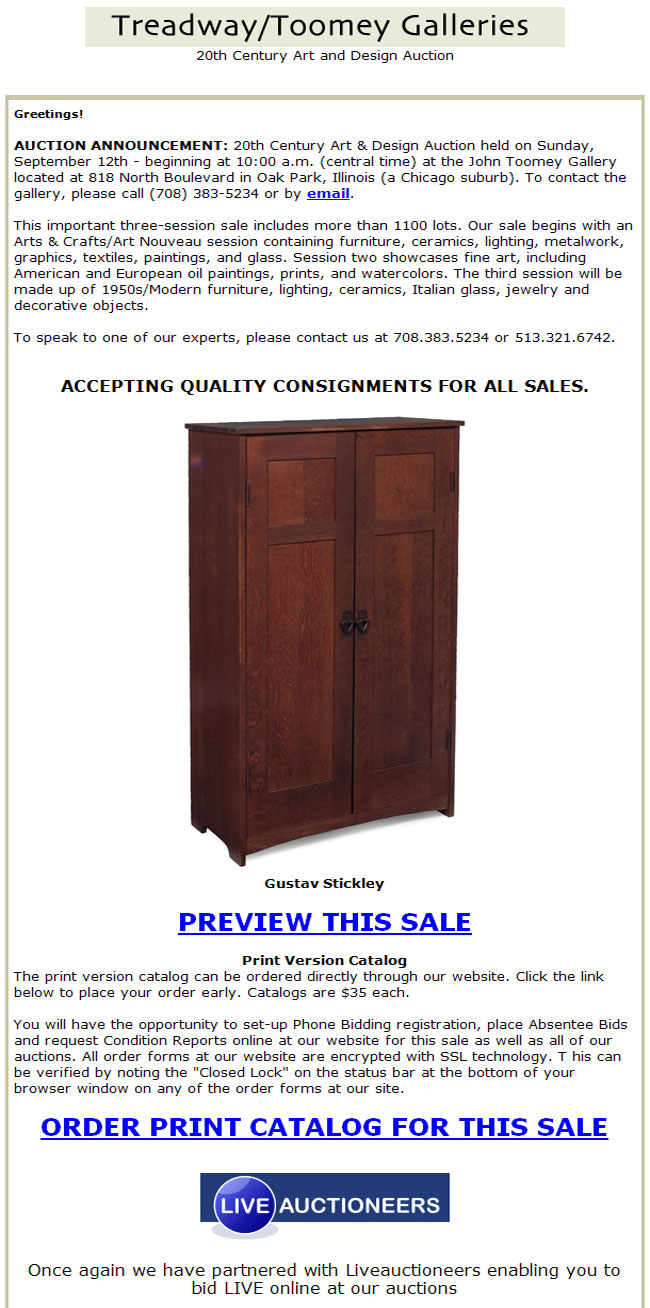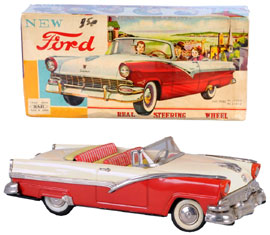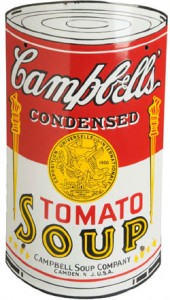Grey Flannel announces details of Aug. 13 Basketball Hall of Fame Induction Auction
Tuesday, July 27th, 2010WESTHAMPTON, N.Y. – Grey Flannel Auctions of Westhampton, N.Y., has announced details of its Fifth Annual Basketball Hall of Fame Induction Auction and other special events associated with the 2010 Naismith Memorial Basketball Hall of Fame induction ceremony. The live auction will take place on Friday, Aug. 13, onsite at the Hall of Fame in Springfield, Massachusetts.
The excitement level is already running high for this year’s enshrinement, which is expected to draw the largest number of Hall of Famers ever to congregate for the prestigious annual event. The Class of 2010, which will be inducted in an evening ceremony on Aug. 13 at the Hall of Fame includes eight individuals and two teams. They are (alphabetically): Jerry Buss, Cynthia Cooper, Bob Hurley Sr., Karl Malone and Scottie Pippen, along with the 1960 USA Men’s Olympic team and the 1992 USA Basketball “Dream Team.” Three legendary players will be honored posthumously: Dennis Johnson, Gus Johnson and the great Brazilian center Maciel “Ubiratan” Pereira.
Grey Flannel Auctions will begin its Hall of Fame activities on Aug. 12 by hosting an invitation-only pre-induction dinner for Hall of Famers, inductees and VIPs at the Hall of Fame’s Center Court. The following afternoon, starting at 1 p.m., Grey Flannel will conduct its 244-lot auction of vintage basketball-related memorabilia.
“I think collectors are going to be ecstatic when they see what’s in store for them at this auction,” said Grey Flannel Auctions’ president Richard E. Russek. “We’ll be offering some of the rarest and most desirable basketball jerseys and uniforms, as well as some great mementos, like the Chicago Bulls 1991-1992 NBA Championship banner that hung in Chicago Stadium.”
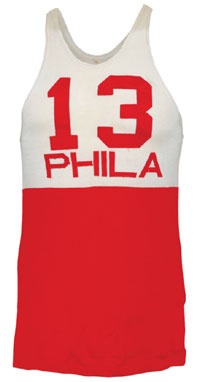
1965-66 Wilt Chamberlain Philadelphia 76ers game-used home jersey (MVP and scoring title season), style used for one year only, reserve $10,000. Grey Flannel Auctions image.
A premier lot to be auctioned with a $10,000 reserve is Wilt Chamberlain’s 1965-66 Philadelphia 76ers game-used home jersey. Exhibiting a style used for only one season, the red and white jersey is emblazoned with the all-time single game point-scoring king’s number “13” and the word “Phila.”
Also entered with a $10,000 reserve is Elvin Hayes’ circa-1970 game-used and autographed San Diego Rockets home uniform. On the front is the name “Rockets,” while the “E” on the back of the jersey needs no further explanation. The number “11” appears on both front and back.
Grey Flannel has put together a very special and unprecedented selection of 12 articles related to the career of the late slam-dunking superstar Dennis Johnson, and each of the items in the sale comes with impeccable provenance: a letter of authenticity from the Johnson family.
Johnson’s 1984 Boston Celtics World Championship player’s ring features a green sapphire shamrock with a central diamond, the name “Johnson” and other symbols and words associated with the revered Boston franchise. The ring carries a reserve of $5,000.
Other highlights among the dozen articles from the Johnson family include Dennis’ 1980 Western Conference game-used All-Star uniform (reserve $2,500), his 1984-85 Boston Celtics game-used home uniform (reserve $2,500), and two multicolored Spalding basketballs commemorating career milestones: Johnson’s 15,000th point and his 5,000th assist. Each has a required minimum bid of $2,500.
Another important commemorative basketball in the sale’s top 10 lots is the one denoting the 47 points scored for the Atlanta Hawks by “Pistol” Pete Maravich on Feb. 8, 1975. The ball is autographed by Maravich in black marker, and comes with a letter of authenticity from JSA as well as a letter from the wife of the fan who received the ball at the game and asked Maravich to sign it that night.
The pride of French Lick, Indiana, Larry Bird, is represented in the sale by a game-used uniform he wore in the 1990 Eastern Conference All-Star Game. The front of the jersey says “NBA All-Star,” and both front and back carry the record-setting sharpshooter’s number “33.” Reserve: $5,000.
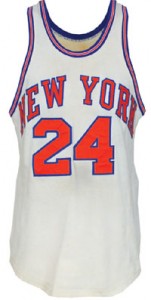
1969-70 Bill Bradley New York Knicks game-used NBA Finals home jersey, worn during series-clinching game, photo match, accompanied by letter of provenance, reserve $5,000. Grey Flannel Auctions image.
Other game-used apparel includes Bill Bradley’s 1969-70 New York Knicks NBA Finals home jersey (reserve $5,000), Steve Green’s 1975-76 Spirits of St. Louis home uniform (reserve $2,500) and the only known Dolph Schayes Syracuse Nats jersey, which was autographed by the 6ft. 8in. prodigy known for his shooting and rebounding skills (reserve $5,000).
Grey Flannel’s Friday, Aug. 13, 2010 auction will take place at the Naismith Memorial Basketball Hall of Fame, 1000 W. Columbus Ave., Springfield, MA 01105, starting at 1 p.m. Eastern Time. In addition to in-person and phone bidding, Grey Flannel welcomes absentee bids, including by phone (please call to reserve a line) and through its Web site: www.GreyFlannelAuctions.com. Printed catalogs are free to all registered bidders. The fully illustrated electronic version of the catalog may be viewed online at www.GreyFlannelAuctions.com.
To request a catalog, register as a bidder or obtain further information on any lot in the auction, call 631-288-7800, ext. 223; email gfcsports@aol.com.
* * *
About Grey Flannel and Grey Flannel Auctions:
Grey Flannel was founded in New York in 1989 by Richard Russek. With its respected team of experts and long-established friendships with athletes and their families, Grey Flannel rose to become the world’s foremost authenticator and dealer of game-used jerseys. In 1994, Grey Flannel became the official appraisers and authenticators for the Naismith Memorial Basketball Hall of Fame. In 1998, the firm was hired by Sotheby’s to authenticate the Barry Halper Uniform Collection, which rivaled in scope even that of the Baseball Hall of Fame. In 1999, Grey Flannel entered the auction arena, and since then has auctioned some of the most important sports memorabilia ever to reach the public marketplace, including Babe Ruth’s 1932 “Called Shot” uniform, which sold for more than $1 million. Grey Flannel continues to achieve record prices, most recently in April 2010 with the $564,930 sale of the iconic New York Yankees home uniform Yogi Berra wore during the 1956 World Series perfect game pitched by Don Larsen.

